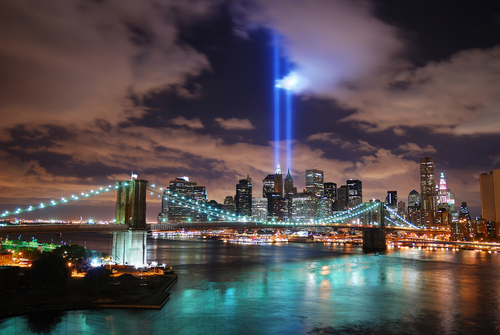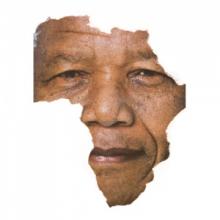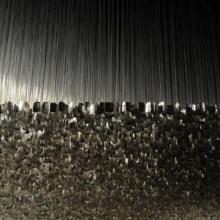memorial
Ashon T. Crawley, author, artist, and professor of religious studies and African American and African studies at the University of Virginia, constructed a memorial for Black church choir directors who died during the U.S. HIV/AIDS crisis. The exhibit, “HOMEGOING,” told the story of the musicians who, as he puts it, “died within a kind of epistemological moment,” where to be a musician in the Black church was to be understood as gay, to be gay was to be understood as HIV-positive, and vice versa.
IN THE EARLY days of the pandemic, I started a death scroll. Not to be confused with “doomscrolling” (a malady related to one’s smartphone), my death scroll was a physical length of paper on which I penned names and death dates as I learned of them.
Across the top I scrawled: “Blessed are you, Lord Our God, Who Is Keeper of the Book of Life. Today, we learned that Sister Death called ...” On March 13, 2020, I wrote the first name: Barbara Clementine Harris. A towering figure in the American church, Harris registered Black voters in Mississippi in the 1960s, marched from Selma to Montgomery in 1965, and was one of the first 11 women “irregularly” ordained as Episcopal priests in 1974 and the first female bishop in the Anglican Communion. But, because of the COVID lockdown, no churchwide memorial service was held for her.
Pandemics bring death. And, as Christians, it’s impressed upon us to remember. Remember the Sabbath. Remember that your ancestors were slaves in Egypt. Do this in remembrance of me. Remember my chains. But ... I have a very bad memory. So, I made the scroll. When I stopped collecting names in late 2022, my scroll held 36. How many names would your scroll hold?

Nadine Seiler admires the fence she has been protecting since Oct. 27. Many of the signs on the fence she has had to repair with tape, plastic wrap, or zip ties after they were vandalized by pro-Trump supporters during various demonstrations since October. “The fence is like my baby, I guard it like a guard dog,” Seiler said. Photo: Madison Muller
Nadine Seiler began protesting then-President Donald Trump in 2017 with one simple sign: a pink piece of paper with the word “RESIST” written across it in black ink. Until late January, that same sign hung among hundreds of others on what community members call “the Black Lives Matter Memorial Fence” in Washington, D.C., near the White House.
Lori Greene is a mosaic artist living in Minnesota. She spoke to Sojourners' Jenna Barnett about creating the first permanent memorial to sexual violence survivors in the United States.
“WHEN SARAH Super asked if I would help create a memorial to survivors of rape and sexual assault, I said ‘yes’ immediately. I’m also a survivor, so it was a no-brainer. Burying pain will not help us recover.
The memorial [in Minneapolis] is painful, but it’s not just pain. I call the first [of the five] panels ‘Sorrow.’ A person in red is curled up in the snow. It’s dark; there are trees everywhere. In panel two are two figures: the same figure, who is clearly crying, and a purple figure holding them. There’s a little sunrise on the horizon. We have a memorial to Holocaust victims. We have the new lynching memorial. And these things are making a difference.
I know you believe you are doing God’s work when you ask me
“Are you a Christian?” and instantly retort to my “No” with “Why not?”
I know you do not know how the hairs stand up on the back of my neck
when first you question my failure to embrace Jesus as my Lord and Savior
and then interrupt with that world-weary “Ahhh ...” as I say,
“Well, my mother’s family was Jewish— ”
Organized by Avaaz, a U.S.-based civic organization that emphasizes global activism, intends for the "Monument for our Kids" to put pressure on Congress to take action on gun control. Images of the striking visual have been widely shared on social media, with the hashtag #NotOneMore.

Auschwitz-Birkenau near Oswiecim, Poland. Image via REUTERS/Kacper Pempel/RNS
Jan. 27 is International Holocaust Remembrance Day, the date the United Nations has chosen to commemorate victims of the Holocaust during World War II. Six million Jews were murdered by Germany’s Nazi regime, along with 5 million non-Jews who were killed. The anniversary, marked each year since 2005, falls on the anniversary of the liberation of the Auschwitz-Birkenau death camp in Poland by the Russian army in 1945. One million people died there.

Image via ChameleonsEye/Shutterstock
If our nation is to remember the lives of all who have suffered because of 9/11, Christians will need to do their part to renegotiate the terms for who and what we remember. Otherwise, “never forget” will remain a well-intended but shallow slogan that encourages us to elevate some lives above others, and to turn a blind eye to the violence, injustice, and hatred directed at Muslims in our name.
If our nation is to remember the lives of all who have suffered because of 9/11, Christians will need to do their part to renegotiate the terms for who and what we remember. Otherwise, “never forget” will remain a well-intended but shallow slogan that encourages us to elevate some lives above others, and to turn a blind eye to the violence, injustice, and hatred directed at Muslims in our name.
In the wake of the latest escalation of the U.S. “war on terror,” it’s time to remember the origin of Veterans Day. In 1926, Congress officially recognized the commemoration of Armistice Day on Nov. 11 with the exhortation, “the recurring anniversary of this date should be commemorated with thanksgiving and prayer and exercises designed to perpetuate peace through good will and mutual understanding between nations.” Armistice Day commemorated the day when World War I hostilities ceased, and had been celebrated informally since 1919 as a day to work for peace.
As a survivor of the Sept. 11 terrorist attacks on the World Trade Center, I worry about how we will remember that tragic day 50, 100, even 200 years from now.
I worry because our nation does a poor job of commemorating our most historic heroes and events. Our efforts to honor history consistently lead to one of two disappointing outcomes.
Our official holidays have become increasingly commercialized. Consider the relatively recent exploitation of Thanksgiving and Martin Luther King Jr. Day.
Virtually all other anniversaries have been marginalized. Consider how little attention is paid each summer to the July 20th anniversary of the first Apollo moon landing, one of humanity’s most impressive achievements.
ST. LOUIS — Justice was a recurring theme as thousands of mourners packed the mammoth Friendly Temple Missionary Baptist Church on Monday for the funeral of Michael Brown, a black teen whose fatal shooting following a confrontation with a white police officer set off weeks of sometimes violent protests.
The Rev. Al Sharpton, among the speakers, called for a “fair and impartial investigation” into the shooting.
“We are not anti-police, we respect police,” Sharpton said. “But those police that are wrong need to be dealt with just like those in our community who are wrong need to be dealt with.”
Benjamin Crump, a lawyer representing Brown’s family, alluded to the “three-fifths” clause in the Constitution for counting slaves (which actually was an anti-slavery clause) and demanded that Brown get “full justice, not three-fifths justice.”
Brown’s body was being laid to rest, but the controversy surrounding the Aug. 9 shooting was far from over. Prosecutors have not determined whether the Ferguson police officer, 28-year-old Darren Wilson, will face charges in Brown’s death.
Create your own memorial prayer altar in remembrance of those you love and will never forget.
President Obama’s “selfie” with prime ministers Helle Thorning Schmidt of Denmark and David Cameron of Great Britain has been making the rounds on social media. Many of Obama’s detractors have taken the opportunity to criticize the President’s picture taking prowess, bringing on “Selfie-Gate.” Take John Kass of the Chicago Tribune, for example:
First lady Michelle Obama sits off to the side, somber, dignified, as the world remembers Mandela. Yet next to her like some goofy adolescent who hasn't yet been taught how to behave properly at a memorial service — her husband — is snapping a memorial to himself.
Hold on a minute there, Kass, because South Africa is teaching us a thing or two about how they “behave properly at a memorial service.” Sure they mourn.
But they also dance.
From the video and images that I’ve seen, there was festive atmosphere at Mandela’s memorial service. This leads me to wonder what “proper behavior” at this memorial service looks like.
Today I had the great honor of saying a prayer at the memorial service for Nelson Mandela, the most important political leader of the 20th century. This was an honor, not only because of Mandela’s stature on the world’s stage, but because he was someone I admired very deeply and personally. His fight for justice and reconciliation is one that has inspired me in the work that we do at Sojourners.
There were several highlights of the service today. There were several choirs, two of which brought each mourner to their feet, clapping along to their versions of Shosholoza and Siyahamba. There were many beautiful speeches and recitations, including a reading of Maya Angelou’s poem for Mandela called “His Day is Done.”
But what stood out to me the most was the homily by Rev. Dr. Allan Boesak, Director of the Desmond Tutu Center at Christian Theological Seminary, Butler University. As he paid tribute to Mandela’s life and described his “long walk to freedom,” he punctuated his remarks with “it ain’t over, until God says it’s done,” a quote from Maurette Brown-Clark’s song of the same name.
IN HIS EULOGY at Baptist pastor, civil rights activist, and author Will D. Campbell’s memorial service in late June, Campbell’s close friend, journalist John Egerton, recalled their first meeting. Campbell was wearing the broad-brimmed black hat that became his signature, with jeans and cowboy boots. At the time, Egerton noted, Campbell was in the middle of “a costume change” from the tweed jacket, clerical collar, and calabash pipe he had affected as a young, Yale-educated liberal minister.
Campbell was a notoriously theatrical figure, as famous for his hats and walking sticks as for his theological pronouncements. In fact, in the 1980s Campbell became a cartoon character in the guise of Rev. Will B. Dunn in the late Doug Marlette’s “Kudzu.” Campbell also dramatized his own life in Brother to a Dragonfly, his National Book Award-nominated 1977 memoir, and in a 1986 sequel, Forty Acres and a Goat.
Another favorite prop in the Will Campbell show was the acoustic guitar he would strum while singing his own country compositions and old favorites like “Rednecks, White Socks, and Blue Ribbon Beer.” Campbell, who was based in Nashville from 1957 on, also became a sort of chaplain to the “outlaw” element in that city’s country music industry. He traveled on Waylon Jennings’ tour bus, and Jennings’ widow, country star Jessi Colter, sang at Campbell’s memorial.
The National Veterans Art Museum in Chicago has an unusual work of art.
When visitors first enter the museum, they hear a sound like wind chimes coming from above them. Their attention is drawn upward 24 feet to the ceiling of the two-story high atrium.
The metal dog tags of the more than 58,000 service men and women who died in the Vietnam War move and chime with shifting air currents. The 10-by-40-foot sculpture, titled “Above and Beyond” was designed by Ned Broderick and Richard Steinbock.
Family and friends locate the exact dog tag of a loved one as a museum employee uses a laser to point to the tag with the name imprinted on the dog tag, now part of a chorus of wind chimes.
After the horror and tragedy in Boston, our heads have been down. This work of art serves as a reminder to look up to hear the sound of the spirit of goodness, compassion, and creativity that can turn tragedy and death into wind chimes played in silence by the air.
 Eleven songs in memory of 9/11 from Bruce Springsteen, Neil Young, Suzanne Vega, Moby and Sinead O'Connor, Mark Knopfler and Emmylou Harris, Leonard Cohen, Tori Amos, John Hiatt, U2, and Hunter Parrish (from 2012's Broadway revival of "Godspell").
Eleven songs in memory of 9/11 from Bruce Springsteen, Neil Young, Suzanne Vega, Moby and Sinead O'Connor, Mark Knopfler and Emmylou Harris, Leonard Cohen, Tori Amos, John Hiatt, U2, and Hunter Parrish (from 2012's Broadway revival of "Godspell").
JERUSALEM — Despite international pressure — including support from both U.S. presidential candidates — the International Olympic Committee has refused to include a moment of silence at Friday's (July 27) opening ceremony for Israeli athletes killed by terrorists at the games 40 years ago.
President Obama and his likely GOP challenger, Mitt Romney, have both called for the IOC to honor the 11 Israelis murdered in Munich in 1972.
"We absolutely support the campaign for a moment of silence at the Olympics to honor the Israeli athletes killed in Munich," Obama spokesman Tommy Vietor said in a statement.
IOC President Jacques Rogge said a smaller, more somber ceremony would better memorialize the tragedy.
IOC officials made a brief statement and held a moment of silence on Monday during a pre-Olympics event in London, where the 2012 games begin on Friday.
"I would like to start today's ceremony by honoring the memory of 11 Israeli Olympians who shared the ideals that have brought us together in this beautiful Olympic Village," Rogge said.
The first wave wrenched the board loose from my fingertips, sending it crashing into my knee and knocking me off my feet.
“You OK, Cath?” I heard someone call from behind me.
“Not really!” I hollered, as someone reached around me to steady the huge stand-up paddle board while I struggled to regain my footing in the icy-cold waters of the Pacific.
My friends, experienced surfers Joel and Rob, appeared at my side, holding onto the board and gently coaching me to wait for the next set of waves to pass before attempting to paddle out toward Second Reef, several hundred yards beyond the shore break.
“You got it?” Rob said, “OK. You’re good to go!”
Gripping the long-handled paddle in one hand, I foisted myself forward (if with less grace than I had hoped) onto the board, while Joel pushed it forward into the momentarily glassy sea between sets.
When her 91-year-old aunt passed away in 2010, Diane DiResta videotaped the eulogies to create a record of the moving words spoken. She wasn't ready to talk about her aunt at the service, so she used an online tool for publishing audio to record her thoughts, then e-mailed the audio file to close family.
And when a cherished 89-year-old uncle died in Las Vegas in February — and there was no funeral service to follow — the New York City resident again turned to technology.
"Since there was no way for the family to share his life and express their grief together, I created a blog," she said. "I added pictures, and family members were able to post their memories of him."
This is Mourning 2.0. Technological advances have dramatically altered how we grieve for and memorialize the dead.
In this new era, the bereaved readily share their sorrow via Facebook comments. They light virtual candles on memorial websites, upload video tributes to YouTube and express sadness through online funeral home guest books. Mourners affix adhesive-backed barcodes or "QR code" chips to tombstones so visitors can pull up photos and videos with a scan of a smartphone.















